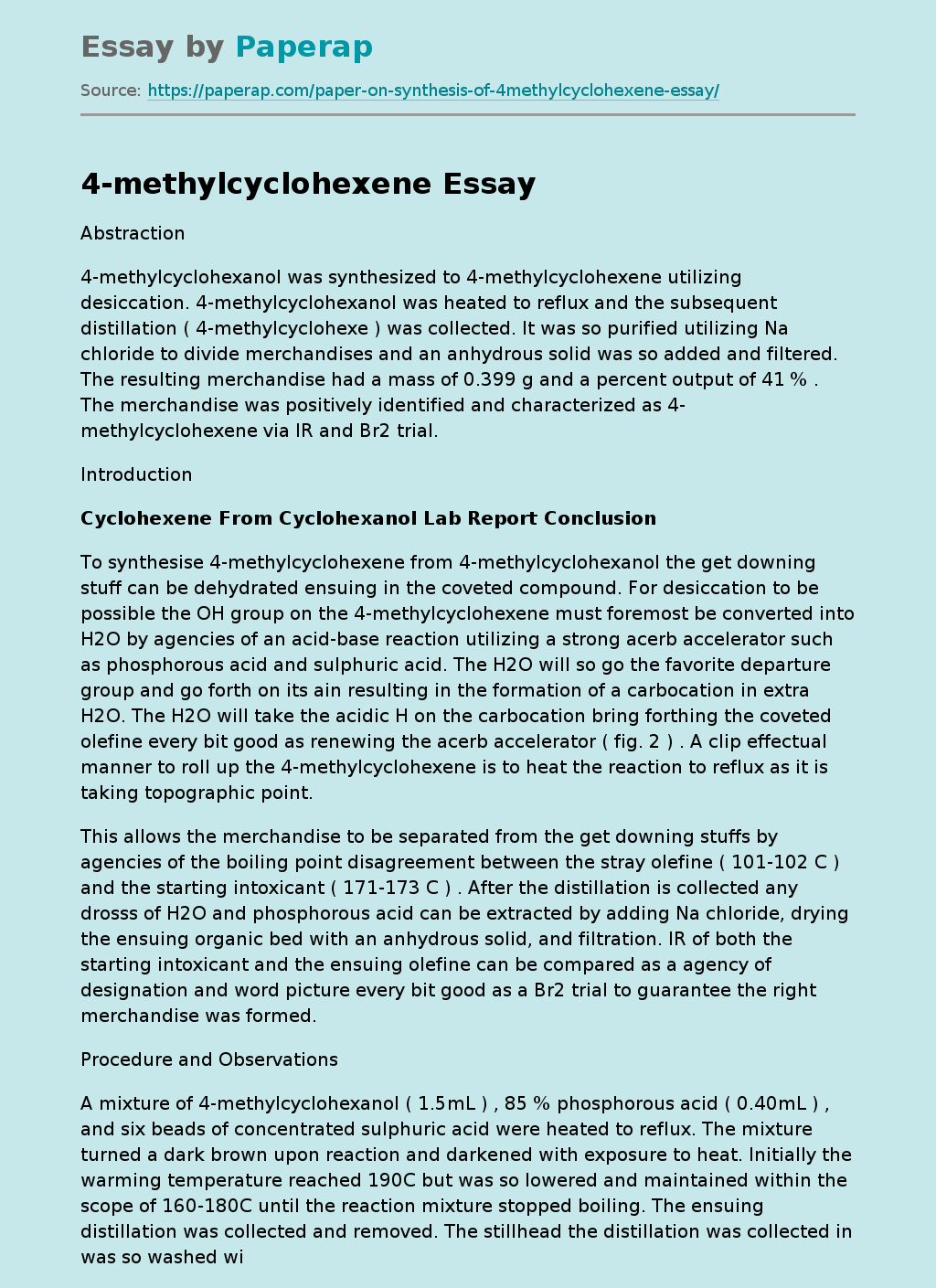4-methylcyclohexene
Abstraction
4-methylcyclohexanol was synthesized to 4-methylcyclohexene utilizing desiccation. 4-methylcyclohexanol was heated to reflux and the subsequent distillation ( 4-methylcyclohexe ) was collected. It was so purified utilizing Na chloride to divide merchandises and an anhydrous solid was so added and filtered. The resulting merchandise had a mass of 0.399 g and a percent output of 41 % . The merchandise was positively identified and characterized as 4-methylcyclohexene via IR and Br2 trial.
Introduction
Cyclohexene From Cyclohexanol Lab Report Conclusion
To synthesise 4-methylcyclohexene from 4-methylcyclohexanol the get downing stuff can be dehydrated ensuing in the coveted compound.
For desiccation to be possible the OH group on the 4-methylcyclohexene must foremost be converted into H2O by agencies of an acid-base reaction utilizing a strong acerb accelerator such as phosphorous acid and sulphuric acid. The H2O will so go the favorite departure group and go forth on its ain resulting in the formation of a carbocation in extra H2O. The H2O will take the acidic H on the carbocation bring forthing the coveted olefine every bit good as renewing the acerb accelerator ( fig.
2 ) . A clip effectual manner to roll up the 4-methylcyclohexene is to heat the reaction to reflux as it is taking topographic point.
This allows the merchandise to be separated from the get downing stuffs by agencies of the boiling point disagreement between the stray olefine ( 101-102 C ) and the starting intoxicant ( 171-173 C ) . After the distillation is collected any drosss of H2O and phosphorous acid can be extracted by adding Na chloride, drying the ensuing organic bed with an anhydrous solid, and filtration.
IR of both the starting intoxicant and the ensuing olefine can be compared as a agency of designation and word picture every bit good as a Br2 trial to guarantee the right merchandise was formed.
Procedure and Observations
A mixture of 4-methylcyclohexanol ( 1.5mL ) , 85 % phosphorous acid ( 0.40mL ) , and six beads of concentrated sulphuric acid were heated to reflux. The mixture turned a dark brown upon reaction and darkened with exposure to heat. Initially the warming temperature reached 190C but was so lowered and maintained within the scope of 160-180C until the reaction mixture stopped boiling. The ensuing distillation was collected and removed. The stillhead the distillation was collected in was so washed with Na chloride ( 1.0ml ) and the subsequent mixture was added to the merchandise. This mixture was shaken and aqueous and organic beds were allowed to organize. The aqueous bed was removed from the organic and the organic dried with anhydrous solid and filtered through a cotton-plugged pipet. The mass of the merchandise every bit good as a per centum output was determined. An IR was taken and compared to the get downing stuff every bit good as a Br2 trial.
Consequences and Calculations
4-methylcyclohexanol get downing mass: 1.164 gexistent 4-methylcyclohexene mass: 0.399 g4-methylcyclohexanol molecular weight = 114 g/mol4-methylcyclohexene molecular weight = 96 g/molPercent output computations:% output = ( existent yield/ theoretical output ) * 100 %1.164 g 4-methylcyclohexanol * 1mol 4-methylcyclohexanol/114 g * 1 mol 4-methylcyclohexanol/ 1 mol 4-methylcyclohexene * 96 g/ 1 mol 4-methylcyclohexene = 0.980 g 4-methylcyclohexene ( theoretical output ) 0.399 g/ 0.980 g = 0.407 * 100 % = 40.7 % = 41 %
Br2 trial:4-methylcyclohexene: 140 beads to make extra4-methylcyclohexanol: 1 bead to make extra
Discussion and Decision
In decision, 4-methylcyclohexene was successfully synthesized via desiccation from 4-methylcyclohexanol. This consequence was verified by comparing the IR spectra of both compounds every bit good as by executing a Br2 trial. The IR spectra for the synthesized stuff lacked the wide O-H extremum found in the spectra of the get downing stuff and which is characteristic of a compound incorporating an intoxicant every bit good as incorporating extremums for both sp2 and sp3 hybridized C-H groups, both of which are consistent with the stereochemistry of 4-methylcyclohexene.
Furthermore, the consequences of the Br2 trial supported the positive word picture of the merchandise as 4-methylcyclohexene. 140 beads Bromine were required until the compound turned ruddy consistent with the chemical science of Bromine and the olefine organizing 1,2?dibromo?4?methylcyclohexane and explicating why the mixture remained colorless for so long. The merchandise was synthesized with a decent to hapless percent output as evidenced by the 41 % . This hapless output really likely was caused by the extra heat ab initio added to the reflux reaction, the consequence of which was coaling and perchance by excessively much acid accelerator being added to the get downing stuff.
4-methylcyclohexene. (2019, Dec 05). Retrieved from https://paperap.com/paper-on-synthesis-of-4methylcyclohexene-essay/

